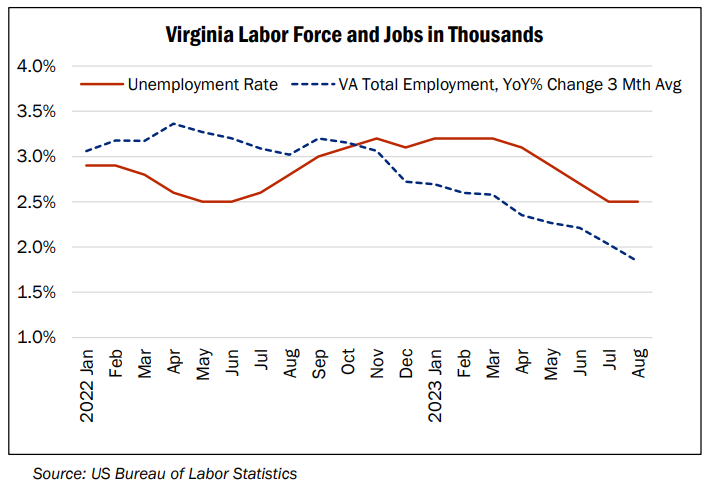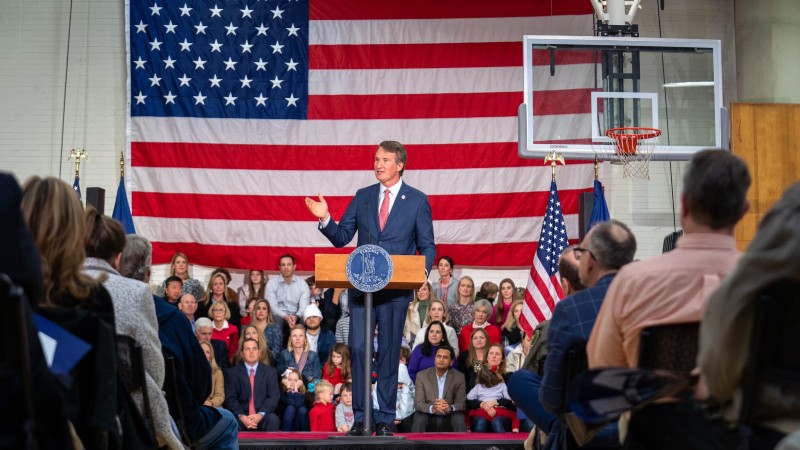In two weeks, the people of Virginia will decide on two competing visions for the future of Virginia. Will they elect a General Assembly favoring Governor Youngkin’s more freedom-oriented policy vision, or will they want to elect a General Assembly returning the Commonwealth to the statist policy vision of former governors McAuliffe and Northam? While much of the current debate in the Commonwealth has focused almost solely on abortion, the number of issues “on the ballot” in this election is much broader and ought to be more closely considered by voters. If readers want a deeper dive into these issues, links to the Thomas Jefferson Institute’s work in these areas are included.
Surpluses are on the ballot in Virginia
Earlier this year, faced with a historic $5.1 billion surplus, Governor Youngkin and Democrats in the Virginia Senate reached a deal to cut $1.05 billion in taxes and allocate $3.7 billion in new, one-time spending. This $3 in new spending for every $1 in tax cuts is backward. Budget officials in Virginia just reported that in the first quarter of this fiscal year, surpluses are continuing to be amassed in Richmond. Coupled with the official projections for spending and revenue for the next few years, the next General Assembly will almost certainly be faced with large surpluses. The winner in November will determine if excess funds are predominantly returned to taxpayers or mostly spent on greater government largess. Governor Youngkin has cut $5 billion in taxes since entering office two years ago, more than the combined tax cuts of McAuliffe and Northam over the previous eight years. More information from TJI on tax and spending can be found here, and here. and here.
Worker freedom vs. union control is on the ballot in Virginia
Approximately forty percent of Virginians now live in areas that have approved collective bargaining for public employees. This will divert needed public funds for schools, municipal services, and public safety to pay for full-time union employees whose sole job will be to bargain for higher wages and to protect often subpar employees. In Fairfax, Loudoun, Alexandria, and Portsmouth alone this is estimated to cost $5.5 million. These organizers will then push to divert county coffers away from public services and towards higher union employee salaries. As an example, the Richmond City union negotiated a 40 percent salary increase over the next three years, while Prince William is seeking a 17 percent increase for its teachers next year. Because unions routinely spend generously on political activity, Virginia’s elections will soon be dominated by union support for candidates that will divert even more money into union accounts. Northam signed the law approving collective bargaining in Virginia, while Governor Youngkin has made its repeal a priority. More information from TJI on unions and collective bargaining can be found here, and here, and here. We also did a public education campaign for teachers here, and here.
Your right to drive an affordable vehicle is on the ballot in Virginia
Despite generous federal and state incentives, expensive electric vehicles (EVs) are less than 0.5 percent of cars on Virginia’s roads and just under 10 percent of new cars sold. Yet, under existing Virginia law, EVs must make up 35 percent of auto makers’ sales in just under three years and 68 percent in just under six years. Not only are these cars priced too high for most buyers in Virginia, but they are proving unreliable for longer commutes and road trips, and EV battery life and battery safety continue to be an issue. Northam signed the legislation deciding what kind of car Virginians are allowed to own, while Youngkin has sought its repeal. More information from TJI on electric vehicle mandates can be found here, and here, and here. We also did a public interest campaign on EVs here.
Reliable and affordable energy is on the ballot in Virginia
The Virginia Clean Energy Act (VCEA) mandates unrealistic and arbitrary targets and deadlines for the use of renewable energy in Virginia that even Dominion Energy now admits cannot be met. This is forcing the closure of several efficient, reliable carbon-producing energy facilities. Worse, Dominion has noted that the push for carbon-free energy significantly impacts the reliability of its energy supply as more of the Commonwealth’s energy will be dependent on intermittent energy sources like solar and wind power that can’t produce needed power without the right weather conditions. Worse, the unmet demand can’t be met by outside sources if other states also transition to intermittent renewables. Finally, the cost to build zero carbon energy in time for the VCEA deadline will increase the cost to residential ratepayers by over 80 percent. Northam signed the VCEA into law, while Youngkin has sought its repeal and has pushed for reliable and clean Small Modular Reactors as an added alternative. More information from TJI on energy can be found here, and here, and here.
Educational freedom and parental rights are on the ballot in Virginia
The Virginia Department of Education recently reported that there has been a significant and persistent learning loss in reading and math for Virginia Students in grades 3 through 8. This loss began before the COVID-19 closures and accelerated after. More than half of these students failed or are at risk of failing their reading SOL exam, while two-thirds are either failing or at risk of failing their math SOL exam. The most extreme decline is in Black and Hispanic outcomes, increasing the performance gap significantly. Other reports by the Department discuss the doubling of chronic absenteeism among students, similar absenteeism among teachers, and a growing number of teacher vacancies. There is growing division between parents and schools over what their children are being taught, over well-documented issues of how schools have handled violence and violent students, and on a parent’s right to be told about decisions or actions their children are making while in school. Youngkin has fought to defend parents’ rights, pledged to ban the use of critical theory in schools, give parents more control over their children’s education, expand school choice through lab schools, and expand scholarships for low-income students. Northam and McAuliffe, on the other hand, focused on increasing funding for public schools, expanding access to early childhood education, and promoting equity and inclusion in schools. More information from TJI on education freedom can be found here, and here, and here, and here, and here.
How the above issues are handled by the next General Assembly could significantly shape the future of the Commonwealth for a generation — be informed!



 Derrick Max is President of the Thomas Jefferson Institute for Public Policy. He can be reached at
Derrick Max is President of the Thomas Jefferson Institute for Public Policy. He can be reached at 